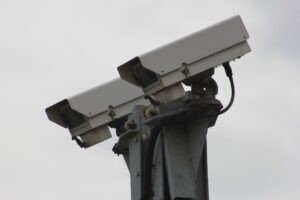CCTV (closed-circuit television) is a TV system in which signals are not publicly distributed but are monitored, primarily for surveillance and security purposes. It records images of people in certain public places including town centres, roads, airports, and on public transport. CCTV images can be used as evidence in court.
It differs from broadcast television in that the signal is not openly transmitted, though it may employ point-to-point (P2P), point-to-multipoint (P2MP), or mesh wired or wireless links. There are about 350 million surveillance cameras worldwide as of 2016. About 65% of these cameras are installed in Asia.

Uses
• Use in schools
• Increasing safety and security in public transport
• Crime prevention
• Crime solving: CCTV can also be used to help solve crimes.
• Vehicle traffic: Many cities and motorway networks have extensive traffic-monitoring systems, using closed-circuit television to detect congestion and notice accidents.
• Sporting events: Many sporting events in the United States use CCTV inside the venue for fans to see the action while they are away from their seats.
• Use in private homes: Many home owners now choose to install CCTV systems on their own homes.
• Criminal use: Criminals may use surveillance cameras to monitor the public.
• Employee monitoring: Organizations use CCTV to monitor the actions of workers.
